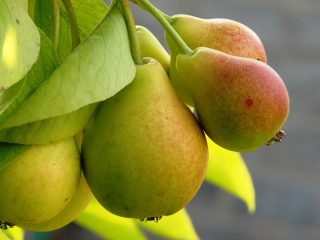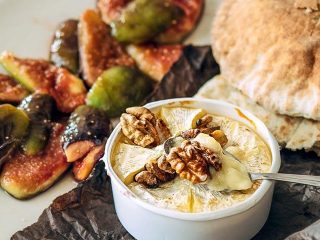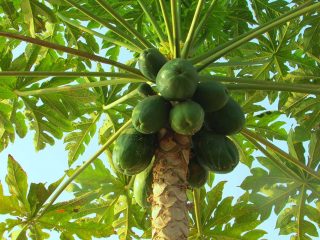Content
Unlike many citrus fruits, poncyrus trifoliata can grow in temperate climates and withstand freezing temperatures. This makes the culture interesting for Russian gardeners. The plant is cultivated both in open ground and in homes. It has average disease resistance and is rarely affected by pests.
Description of poncirus with photo
Poncirus trifolia produces juicy fruits in different climatic conditions, and is not picky about the soil. From the outside it is an ordinary shrub with branched shoots and spines pointed like needles. They grow up to 5-6 cm.

The fruits of Poncirus trifolia help with stomach pain
As for the crown, its dimensions are different - they depend on the care of the owner. In fertile soil, with regular watering, the poncirus plant can reach 6.5 m. At the same time, the average length of the leaf blade remains the same - from 8 to 11 cm. The foliage is colored bright green, indicating the tropical history of the species. With the arrival of autumn cold, it turns yellow.
In the early stages of development, the bush grows at a slow pace. Four years after landing, he completes adaptation and feels calm in the future. Then the number and size of the fruits increase. Every year the three-leaved poncirus grows up to 60 cm.
The fruits of Poncyrus trifoliate (trifoliate) are a citrus fruit. It is covered with yellow porous skin. The taste of wild lemon is very sour, there are bitter undertones. However, the fruits contain a lot of essential oil, which makes them incredibly healthy.
Poncirus flowering
Poncirus trifolia is a dioecious plant, that is, it produces flowers with reproductive organs of both sexes. Large (up to 7 cm in diameter) corollas, as well as long petals, create a beautiful composition. The number of free stamens varies, on average - 8 pcs.
For designers, the trifoliate poncirus is a godsend. In addition to its luscious foliage and colorful fruits, it exudes a pleasant citrus aroma. Unlike its relatives, the species forms buds in mid-autumn. The buds open in May. When grown outdoors, they are visited by pollinators; at home, the pollen is brushed off with a brush.

Poncirus trifolia has snow-white flowers
Is it possible to eat
Trifoliata is a frost-resistant lemon. And although it is called wild, the fruits are safe to eat. They can be eaten in the same quantities as lemons found in stores. However, they are not that tasty. Having chewed the slice thoroughly, a person soon realizes that it is difficult for him to swallow it.
Therefore, fresh poncirus three-leaved is not eaten. It is sprinkled with sugar, like privet fruits.
Methods of application
The culture is bred as a rootstock for other plants. This use is explained by its high winter resistance and ease of crossing with related species. Several new varieties have been grown based on lemon, both decorative and edible.
The three-leaved poncirus also has other interesting qualities. Because of its bright taste, it is added to some dishes, and in Asia, lemon is used to make seasonings. Poncirus trifolia is used as a marinade for meat. The fruit is the main ingredient for making marmalade. Many people make jam based on it.
Three-leaved poncyrus is widely known in the perfume industry, since essential oils are one of the ingredients in creating perfumes. In addition to cooking, the pulp is used in the preparation of vitamin complexes and some brands of wine.

The peel of the poncirus trifolia can be spread around the house to improve the aroma.
Scientists consider the plant to be very promising. It has healing properties, which are still debated. Research has been ongoing for several years. In folk medicine, things are simpler - people make infusions and decoctions for medicinal purposes from fruits and shoots.
Poncirus trifolia cures many ailments:
- bad stool;
- heartburn;
- low blood pressure;
- cholesterol deficiency;
- pimples, ulcers
The fruit, like other citrus fruits, contains vitamin C, which is beneficial for the immune system. Among other things, regular consumption of lemon helps improve bone health. The product relaxes the nervous system, saving you from insomnia.
When the nasopharynx is affected, the plant juice causes an unpleasant sensation, irritating the throat.
Features of growing poncirus
The first few years, the three-leaved poncirus grows very slowly. After the adaptation period, a phase of active development begins. Then the first fruits appear and the buds open.
In Russia, trifoliate is cultivated in apartments or in open ground. Residents of the middle zone are recommended to grow three-leaved poncirus at home, in a greenhouse. In the southern regions, outdoor planting is allowed. However, in winter the plant will still need shelter.
In the open ground
Wild lemon can grow in different climates and soils. The more fertile the substrate, the faster it takes root. A favorable location is well-drained and slightly moist soil. The site must be protected from occasional drafts and accessible to daytime sunlight.

If in the growing area negative temperatures drop below 22 degrees, a shelter is provided for the three-leaved poncirus
After rooting, the species is moistened, especially if there is a drought outside. In this case, water once a week. In autumn, moisture-discharging irrigation is necessary. Mineral fertilizers are applied at the end of spring. They should have a lot of nitrogen. In September, the three-leaved poncirus is mulched with any available material.
The species is not afraid of annual pruning. However, it should only be carried out in March or early April. To improve the decorative appearance of the crown, it is trimmed to one third of its length.In the West, the culture overwinters on its own.
Trifoliate at home
In indoor growing conditions, it is necessary to achieve uniform lighting. Since the crop is tropical, it should be bright. Poncirus trifolia is placed on the eastern windowsill, and in winter they use artificial lighting. Bright foliage does not suffer from burns, so it is not shaded.
Botanists recommend using store-bought soil. If you have perlite, you can mix it with the soil in a concentration of 1:5. Holes are made in the planting container to allow moisture to escape. Moving on to watering, it must be said that drying out of Poncirus trifolia is unacceptable. The same applies to excess fluid. The moisture schedule is set up so that the soil remains dry only on the surface (2 cm). In winter, watering is reduced.
Three-leaved poncyrus is a citrus plant. In order for the fruits to be juicy, the owner needs to control the air humidity. In spring and summer it should be consistently high. If the room is poorly heated, in winter the humidity is reduced to medium.
Fertilizing is used before the arrival of autumn - no more than twice a month. You can buy them or prepare them yourself.

To make Poncirus trifolia feel comfortable, the room is regularly ventilated in the summer
In the cold season, the plant should be kept at a temperature of about 10 degrees. If this is not possible, place it in a cold place - on a windowsill, balcony, inside the porch.
Reproduction methods
Lemon poncirus, whether outdoor or indoor, can be propagated using cuttings and seeds.The difference between the methods lies in the speed of obtaining sheets.
Cuttings
Use spring or summer shoots, having previously treated them in a root formation stimulator. The material is planted in loose nutrient soil and covered with a bottle. The roots will appear in 40-60 days.
Seeds
The fruits of the plant contain about 30-40 grains. They are planted in separate containers in pairs. This will allow you to avoid picking, which is sometimes unsafe for the roots. When two sprouts appear, one of them is cut to the surface of the ground. Under no circumstances should you pull it out.
How to prepare trifoliata seeds
To minimize the risk of material loss, the seeds are soaked in the Heteroauxin preparation. It is diluted with water and the grains are immersed for five hours. After this, the plant is planted in the soil, the trifoliate is covered with film, and after a week it is checked whether the sprouts have hatched. They are transferred to a permanent place after 90 days.
What to do if the poncirus turns yellow in the spring
Three-leaved poncyrus is sensitive to root trauma. Early yellowing is a sign that the crop has put energy into restoring its roots. Therefore, they try to carry out transplantation rarely, and preferably just once.

One of the factors influencing the color of the trifoliate poncirus is disease damage
Yellowing may be a symptom of improper watering. Swampy or too dry soil does not create suitable conditions for the three-leaved poncirus. Due to a lack of mineral and organic substances, the foliage turns pale.
Diseases and pests
Poncirus trifolia resists most diseases and pests. But during his life he can get sick from viruses. In this case, damage to the bark and yellowing of the shoots are observed. Fungal diseases are quite rare.
When grown in open ground, the trifoliate poncirus becomes interesting to pests - whiteflies, spider mites, and scale insects. Means for fighting can be different, from folk recipes to chemicals.
Conclusion
Pontsirus three-leaved is one of the few citrus fruits suitable for growing in the middle zone. Although the fruits are not as tasty, they are rich in essential oils. These substances are beneficial for skin health. The tree is decorative and combines with other garden plants.








